


|



|
|
|
|
|
|
|
Experiments involving Interfacial Hydrodynamics,
Wetting and Non-wetting, Complex fluids and general "Soft Matter". |
|
|
Spreading flowers, with Angelina Aessopos, Vladimir Entov, Anette (Peko) Hosoi , Marc Fermigier and Gareth McKinley |
|
Gobbling droplets,
with Christian Clasen , Gareth McKinley & Vladimir Entov |
|
Dripping of a jelly liquid,
with Christian Clasen , Gareth McKinley & Vladimir Entov |
|
|
Concentrated surfactant
solutions eventually exhibit particular molecular structures
(“worm like micelles”) which lead to a jelly liquid. The material
behaves as a soft elastic solid when a light stress is applied but
flows as a liquid under higher stresses.
When a droplet of such a liquid drips from a pipette, a long thread connects the droplet to the pipette and progressively necks and breaks down when the thread reaches a certain diameter. Click on any picture to watch the video (2.2Mo).
|
| Rolling Stones, |

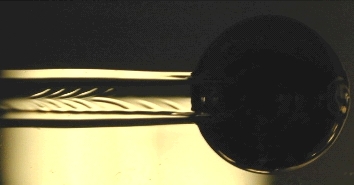
Once deposited on a tilted planar surface
coated with some viscous liquid, a sphere rolls down and slides at
the same time. Tire prints like patterns are formed behind the ball. Click on the pictures to
watch "stones" racing inside a rotating drum (2.7Mo)
|
|
Fingering instabilities in viscoelastic liquids,
with Ryan Welsh & Gareth McKinley |
|
Wrinkling of elastic membranes,
with Christophe Riera , Gareth McKinley & L.Mahadevan |
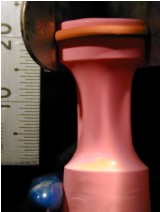
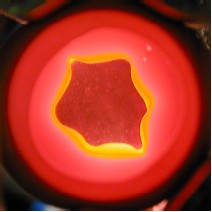
Wrinkles can grow when an elastic membranes
is stretched between two clamps. This pattern results from a competition
between tensile and bending stresses and mainly depend on the geometry
of the sample. This experiment provides a simple analogy with the elastic
oinstabilitybserved with visco-elastic fluids. |
|
Ganesha instability,
with Gareth
McKinley
&
L.Mahadevan |
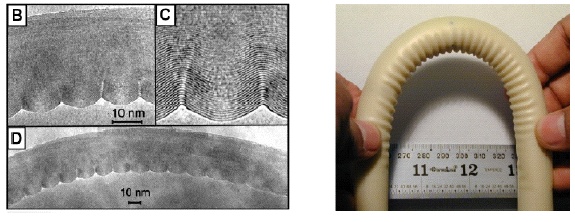
Multi-walled nanotubes exhibits
periodic ripples when they are bent. This instability essentially depends
on the tubes geometry but not on the material properties. The same popliteal
ripples are also observed with macroscopic rubber sheet scrolls or even
on elephant trunks!
|
|
Ex-vivo rheology of spider silk, with Nikola Kojić, Christian Clasen & Gareth McKinley |

Nephila clavipes
spider (female) and one of her major ampulate glands
Although spider silk has been revered during last decade for its unmatched mechanical properties, very little is known about the rheological properties of the spinning dope. Determining the shear and extensionnal rheology of the spinning dope should give some guidance to understand the complex spinning process occurring along the spider spinning canal. |
|
Super Hydrophobic Surfaces,
initially with David Quéré
& Denis Richard, |
|
The shape of Tektites,
with Tim Kreider, John Bush , Linda Elkins Tanton , Pascale Aussillous and David Quéré |
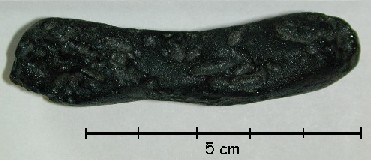
Tektites are believed to be the "splashes"
from the impact of big meteorites on the Earth. The molten silica
material (mainly from terrestrial origin) would be ejected with some
spinning motion which deforms the liquid drops. These rotating shapes
are often frozen by the cooling down of the liquid during its flight. |
|
Liquid trains in a tube,
with David Quéré |